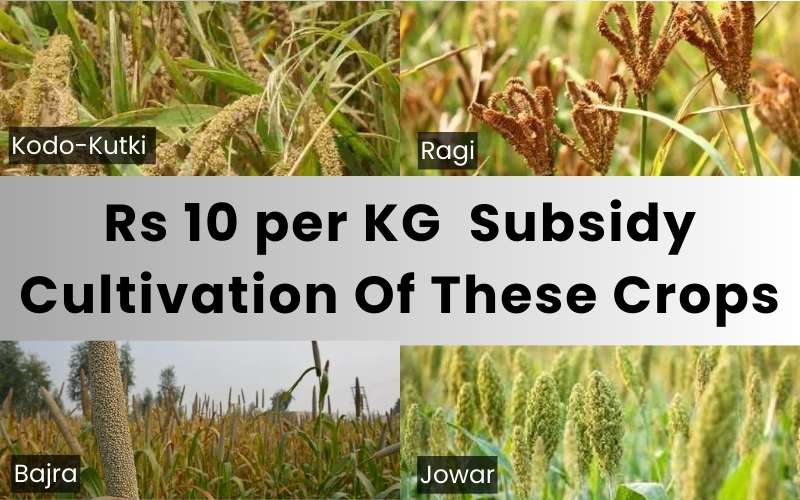Introduction:
The government has approved the Rani Durgavati Shri Annapurna Incentive Scheme to boost the production of coarse grains (Shri Annapurna) in the country.The government is encouraging the cultivation of these crops through various initiatives. For this purpose, several schemes are being implemented.
Rani Durgavati Shri Annapurna Incentive Scheme in the state:
As part of this effort, the Madhya Pradesh government has decided to launch the Rani Durgavati Shri Annapurna Incentive Scheme in the state. Under this scheme, farmers engaged in the cultivation of Shri Annapurna crops will receive an incentive amount of Rs. 10 per kilogram.
During a cabinet meeting held on Wednesday, January 3, chaired by Chief Minister Dr. Mohan Yadav at the Shakti Bhavan in Jabalpur, the decision was taken.
The Rani Durgavati Shri Annapurna Incentive Scheme aims to promote the production of coarse grains such as Kodu-Kutki, Ragi, Jowar, Bajra, and others. Farmers involved in the cultivation of these crops will receive a financial incentive of Rs. 10 for every kilogram produced. The incentive amount will be directly transferred to the bank accounts of the farmers.
It’s worth noting that Prime Minister Narendra Modi has initiated a Millet Revolution in the country, with the year 2023 declared as the International Year of Millets. In Madhya Pradesh, the cultivation of Kodu-Kutki (Sugar Free Rice) takes place in various districts, including Mandla, Dindori, Balaghat, Chhindwara, Anuppur, Sidhi, Singrauli, Umaria, Shahdol, Seoni, and Betul.
The Rani Durgavati Shri Annapurna Incentive Scheme aims to enhance the income of Kodu-Kutki farmers by developing a value chain with a focus on crop production, storage, processing, marketing, procurement, and brand building.
The Significance of Coarse Grains: Exploring Kodu-Kutki (Sugar Free Rice), Ragi, Jowar, and Bajra in Madhya Pradesh
When it comes to nutrition, the limelight often shines on conventional grains like rice and wheat, overshadowing the crucial role played by coarse grains such as Kodu-Kutki, Ragi, Jowar, and Bajra. These grains, often underestimated, not only have cultural importance in Madhya Pradesh but also contribute significantly to the region’s agricultural fabric.
Importance of these coarse grains and understand the opportune time for their cultivation in Madhya Pradesh.
1. Nutritional Powerhouses: Kodu-Kutki (Sugar Free Rice), Ragi, Jowar, and Bajra
a. Kodu-Kutki:
Renowned for its resilience and adaptability, Kodu-Kutki is a type of millet that thrives in diverse climatic conditions. Loaded with fiber, it aids digestion and serves as a sustainable source of energy.
b. Ragi (Finger Millet):
A gluten-free grain, Ragi is a nutritional powerhouse, boasting essential nutrients like calcium, iron, and fiber. Its significant contributions to bone health make it a valuable addition to our diet.
c. Jowar (Sorghum):
Packed with antioxidants and dietary fiber, Jowar supports cardiovascular health and helps regulate blood sugar levels. Its versatility in culinary applications adds to its popularity.
d. Bajra (Pearl Millet):
Drought-resistant and nutritionally rich, Bajra provides proteins, fiber, and essential minerals. Its adaptability in various recipes makes it a staple in many households.
2. Environmental Benefits:
Coarse grains, such as Kodu-Kutki, Ragi, Jowar, and Bajra, are well-suited to Madhya Pradesh’s agro-climatic conditions. These crops, known for their hardiness, require less water, promoting environmentally friendly practices. Additionally, their cultivation aids in soil conservation, preventing erosion and contributing to sustainable agriculture.
3. Best Suitable Time for High Production in Madhya Pradesh:
a. Kodu-Kutki:
Optimal sowing time for Kodu-Kutki is during the monsoon season, typically between June and July. This ensures the crop receives sufficient water for germination and initial growth.
b. Ragi:
Ragi cultivation is best suited for the post-monsoon season, from July to October. Adequate rainfall during this period supports the growth of this hardy crop.
c. Jowar:
Jowar is ideally planted during the kharif season, with sowing typically done in June to July, coinciding with the onset of monsoon for optimal moisture.
d. Bajra:
Bajra thrives in arid and semi-arid regions, making it an excellent choice for Madhya Pradesh. Sowing Bajra from June to July ensures optimal growth.
4. Promoting Sustainable Agriculture:
Encouraging the cultivation of coarse grains aligns with the principles of sustainable agriculture. Diversifying crops contributes to soil health, reduces the risk of pests and diseases, and ensures food security in the region.
Conclusion:
Coarse grains like Kodu-Kutki, Ragi, Jowar, and Bajra are not merely dietary choices; they are integral components of Madhya Pradesh’s agricultural landscape. By understanding the opportune time for their cultivation, we can champion sustainable agriculture, ensuring a steady supply of these essential grains. Embracing the nutritional richness of coarse grains is a commitment to our well-being, the environment, and the prosperity of our communities.
Know More About Prince Khanuja




